Which psychiatric treatments work best for which patients and why? That is a question that psychiatrists and psychologists grapple with in clinical practice every day. Likewise, for decades psychotherapy researchers have asked similar questions empirically: namely, which treatment, patient, and therapist factors contribute to negative or positive outcomes in psychotherapy (
1,
2)?
Psychotherapy is a mainstay for the comprehensive treatment of many psychiatric disorders, often being coupled with medications for the management of symptoms. Adverse reactions to medications are routinely documented in the process of approving the drug for use. But what do we know about the potential for psychotherapy to be ineffective—or worse, harmful? A prominent recent example of possible harm resulting from psychotherapy came from David Morris, a former Marine writing in the
New York Times, who wrote compellingly that he felt the therapy (prolonged exposure therapy) retraumatized him and significantly worsened his symptoms (
3). Others have noted that real-world efficacy and retention rates for this “gold standard” therapy are low, with a significant proportion of nonresponders (
4). Even those who respond to treatment may still have very significant symptoms of PTSD (
4).
A recent contribution to the empirical literature on optimizing outcomes and mitigating harm in psychotherapy is the meta-analysis conducted by Vittengl et al., reported in this issue of the
Journal (
5). These investigators reviewed the data of 1,700 adults from 16 randomized clinical trials comparing the efficacy of cognitive-behavioral therapy (CBT) to pharmacotherapy for unipolar depression. Analyses focused particularly on a comparison of pre- and posttreatment scores from the Hamilton Depression Scale (HAM-D; assessed by the clinician) and from the Beck Depression Inventory (BDI; rated by the patient) for patients who significantly deteriorated, had minimal/no response, or had unusually positive improvement with either treatment. The ultimate aim of this meta-analysis was to identify predictors of deterioration, nonresponse, or unusual improvement in order to match depressed patients with specific therapeutic modalities to optimize outcomes.
Results indicated that frequencies of deterioration, extreme nonresponse, superior improvement, and superior response were quite low and did not differ significantly between CBT and pharmacotherapy. Rates of “any negative outcomes” and “any unusually positive outcomes” overall were similar among study patients. In general, patients with less severe illness had better outcomes. Interestingly, clinicians and patients did not universally share perspectives on whether treatment yielded positive or negative outcomes, based on their respective HAM-D or BDI ratings, which might measure different clinical phenomena. Finally, differential treatment selection (CBT versus pharmacotherapy) was not supported by the current results based on symptom levels and patient characteristics to prevent negative outcomes. However, the results indicated that choice of pharmacotherapy versus CBT may increase the likelihood that patients will discontinue treatment and have superior treatment response as rated by clinicians.
An important consideration raised by this study’s authors is that psychotherapy, as well as pharmacotherapy, can lead to deterioration in a subset of depressed patients. While the rates of deterioration found across the 16 clinical trials were low, these findings might not accurately reflect actual rates of deterioration in naturalistic clinical settings. For example, in a well-run clinical trial, therapists receive extensive supervision for manageable caseloads and have frequent monitoring of change with repeated outcome measures, which might inoculate patients against deterioration. In contrast, a practitioner conducting psychotherapy as part of her professional practice may not address breaches in the therapeutic alliance that could contribute to negative outcomes, or may not discuss whether exploration of a particular topic causes emotional pain without bearing therapeutic fruit. The real possibility of deterioration as a result of psychotherapy also raises the question of informed consent. In clinical practice, psychiatrists who provide medications to patients seek informed consent by disclosing the treatment’s potential benefits and risks, including nonresponse. Presuming that adverse events do occur in the course of psychotherapy, should we provide our patients routinely with information about benefits and risks before treatment begins?
Experts in the field of psychotherapy research have long advocated for the importance of studying possible adverse outcomes in psychotherapy (
1,
6,
7) and the deleterious consequences of “harmful therapists” (
8) and “potentially harmful therapies” (
9). Questions about the identification, nature, and management of adverse events that can occur during psychotherapy remain only partially answered by current data. Little consensus on the definition of an adverse event in psychotherapy exists. Most practitioners would agree that premature termination from psychotherapy is usually a negative outcome and adverse event. However, beyond that, perhaps the definition may have to be tailored to the specific therapy modality (CBT, interpersonal, psychodynamic, etc.) and the unique interventions.
Not all practitioners are willing to acknowledge that adverse events are possible in psychotherapy (
10). The data demonstrate that researchers are much less likely to even consider the possibility of adverse events in protocols providing psychotherapy alone compared with protocols that provide medications alone or medications and psychotherapy (
11). It has also been proposed that research studies that yield data elucidating negative psychotherapy outcomes (no benefits) are often not published, thus skewing the empirical literature in favor of positive versus negative outcomes (
7).
Vittengl and colleagues (
5) comment that psychotherapy might produce negative outcomes when psychotherapists are confrontational or over-interpret common experiences and patient characteristics as pathological. This sentiment is in agreement with psychotherapy models that promote alliance-focused strategies to improve adherence and outcomes. One such model is the alliance-focused therapy model of Safran and Muran (
6). In this model, the therapist needs to pay heightened attention to even small ruptures in the therapeutic alliance (e.g., failing to fully empathize with a patient, allowing interruptions within a session, or being late to an appointment) and to work toward their reparation. For the patient, the therapist is a psychological proxy for early attachment figures. This “rupture-repair” process instills in the patient the notion of the therapist as a flawed, but ultimately beneficent and consistent attachment figure, which can help to heal insecure attachment issues in the adult. In this treatment, is it appropriate to classify therapeutic rupture as an adverse event when the rupture itself is integral to the treatment? Perhaps the outcome of the repair process, either greater understanding between clinician and patient (positive outcome) or deeper rupture, at its worst resulting in the patient leaving treatment prematurely, can be an indicator of when a rupture is an adverse event. However, that said, there is clinical evidence indicating that even ruptures of this magnitude resulting in the patient dropping out can have a positive effect on the patient. For their analysis, Vittengl et al. chose to use changes in the HAM-D and BDI to denote negative consequences of therapy, but perhaps more discrete measures, tailored to the therapy and possible adverse events, can better denote negative consequences of treatment.
In summary, much has yet to be understood about the frequencies, predictors, and moderators of negative outcomes and adverse events in psychotherapy. Future research in psychotherapy needs to continue to focus not only on optimizing positive outcomes, but also on preventing adverse events. As we learn more about the patient, therapist, and treatment factors that contribute to positive and negative outcomes in psychotherapy, perhaps the elusive process of how to match specific patients to specific treatments to optimize outcomes will be known and empirically sound.

